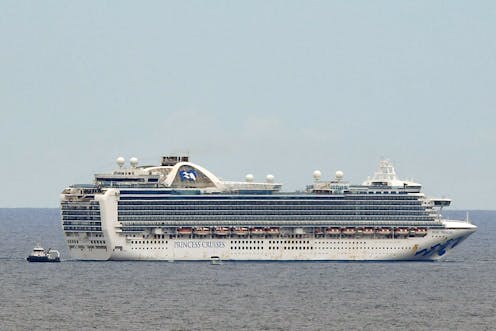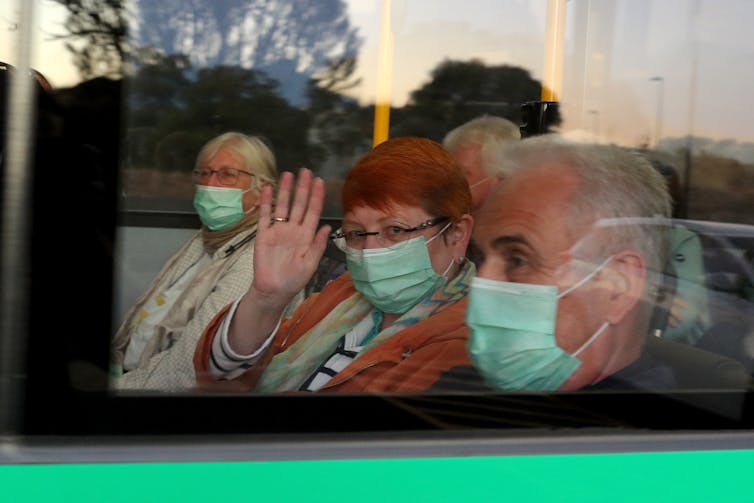 Joel Carrett/AAP
Joel Carrett/AAPThe spectre of large ships with people desperate to come ashore is not a new sight in Australia.
In 2001, the MV Tampa infamously sought to enter Australian waters off Christmas Island to discharge more than 400 asylum seekers who had been rescued by the Norwegian vessel.
It is estimated that 15,000 crew members are now stranded on 18 cruise ships floating around Australia, with mounting concerns that coronavirus will take hold and spread.
The circumstances for each ship may vary, but the fundamental rules of international law remain the same.
 Passengers from the cruise ship MS Artania en route to their charter flight from Perth back to Germany last week.Richard Wainwright/AAP
Passengers from the cruise ship MS Artania en route to their charter flight from Perth back to Germany last week.Richard Wainwright/AAPDuty to render assistance
For those at sea, there is a duty for masters of vessels to render assistance to those in distress. States must fulfill this obligation, too.
Australia could be seen as fulfilling this responsibility with its plan to send doctors to the cruise ships to evaluate sick crew members. An at-sea boarding is challenging, though, and requires the consent and cooperation of those on board.
When the vessel itself is in distress, the international law of the sea allows for it to enter a port of refuge.
Though countries exercise sovereignty over their ports and are entitled to control which vessels enter, an exception exists under customary international law to allow ships in distress to dock.
This is what happened in 2001 when the master of the Tampa issued a distress call to warrant his entry to Christmas Island.
But what counts as distress? Essentially, it is when there is a clear threat to the safety of those aboard the ship.
Traditionally, this related to situations when a vessel had a broken mast, damaged sails or malfunctioning engines or other mechanical failures requiring repair. A vessel could enter into port and seek the repairs needed before continuing on its journey.
The Tampa’s distress, however, was caused by the fact it was carrying an excess number of people who required more food, water and medical attention than the vessel was equipped to provide.
International law protections for crews
What about a cruise liner with a crew of 1,000 who live in close quarters and are exposed to the coronavirus? A situation of distress could well arise on these ships, as well.
International law has minimum requirements for the crew operating a ship. At the moment, it would seem the crew on a cruise liner would be divided between those who are essential for the running of a vessel and those whose jobs are to look after the passengers.
A situation of distress would be more easily established when the crew responsible for the actual running of the vessel are unwell and unable to perform tasks essential for the safety of the ship.
Read more: Coronavirus has seriously tested our border security. Have we learned from our mistakes?
The crew members also have core rights that are set out in the Maritime Labour Convention, which came into force in 2013. It sets the working and living standards for crews working on ships internationally.
Under this convention, seafarers who are in need of immediate medical care are to be given access to medical facilities on shore. Australia is bound by this obligation for vessels located in its territorial waters, regardless of whether those ships are foreign-registered.
Australia has implemented the convention under its own Navigation Act and, most particularly, the Marine Order 11.
That order requires the owners of vessels
put in place measures for the health protection, medical care and essential dental care for seafarers on board.
This obligation extends to ensuring that
seafarers have health protection and medical care as comparable as possible to that available to workers on shore, including prompt access to: (i) necessary medicines, medical equipment and facilities for diagnosis and treatment; and (ii) medical information and expertise.
This order applies to Australian vessels. The question is whether the same rules apply to a foreign-registered vessel.
The Ruby Princess, for example, is registered to the Bahamas. The Bahamas is bound by the Maritime Labour Convention, which sets out similar requirements to those in Australia’s Marine Order.
However, the vessel owners do not have full responsibility for the well-being of crews on board. The Maritime Labour Convention makes clear that Australia is duty-bound to offer medical care to crew on ships in its territorial waters.
Read more: Memories overboard! What the law says about claiming compensation for a holiday gone wrong
The convention does not indicate who has primary responsibility to provide medical assistance in cases like these, but the shipowner does have financial liability under the treaty to defray the expenses of such treatment. What matters is the crew receives the necessary medical care.
For Australia, there is still a balance of rights to be achieved. Under international law, a state might refuse access to its ports for a ship that poses a serious and unacceptable safety, environmental, health or security threat to it. A pandemic would no doubt count in this regard.
Port states have the right to protect their local populations in different ways, consistent with international health regulations put forth by the World Health Organisation and with the International Ship and Port Facility Code.
Yet, the safety of persons on board must be assured, as well.
Natalie Klein does not work for, consult, own shares in or receive funding from any company or organisation that would benefit from this article, and has disclosed no relevant affiliations beyond their academic appointment.
Authors: Natalie Klein, Professor, UNSW
| < Prev | Next > |
|---|








